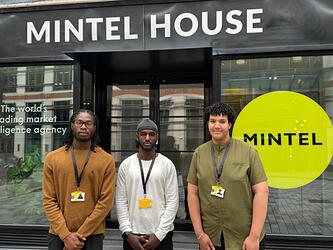Catching-Up With The Big Players: Start with A Long Lunch.
As a recent refugee from the world of big corporates, I’ve been fascinated to observe attitudes to the “majors” in the rest of the Market Research community. Often they are portrayed as monoliths run by corporate “bean counters” who, while fundamentally uninterested in research quality, nonetheless somehow steal the best clients leaving”decent” smaller MR companies with nothing but crumbs.
This kind of “Walmart versus the family store” characterisation is, I am afraid, as superficial as the original retailer version. In fact some of the advantages ascribed to the majors are not as significant as might be thought, anda change of focus by mid/smaller companies could help them become more competitive. Without giving away too much, the guts of my advice to them boils down to: “lusting after your rich neighbour’s glitzy clients will only cause problems”, plus a suggestion to “have lunch with someone you have little in common with, and whose approach you may not particularly like”
Dust Off The Credit Card: It’s Time For Lunch!
While working in any big company can involve frustrations, it is not usually the kind of creative death sentence implied in some on-line discussions. Overall, I found it fascinating. Big companies have such diversity of clients, people and services that it is possible to get involved in all sorts of interesting work if you search it out. As one of my ex-colleagues put it: “it’s like a kid working in a lolly shop … there are just so many jars full of different kinds of information, and so many people with good ideas to sample”. The problem for the majors is that, due to size, complexity, speed they’ve grown etcetera, it is often hard for people working in them to even know about all these “lollies”, let alone package and market them nicely for clients. That’s the challenge for bigger organisations: most accept they need to do a better job of pulling their assets together, but this is very much a work in progress in most cases. One problem they face is that the very range of possibilities tends to make prioritisation tricky to manage. More importantly, there aren’t many people with the cross-methodology experience and intellectual grunt to create the analytical and marketing frameworks necessary to underpin complex services. Understandably then, bigger companies often focus on integrating the big syndicated services (ratings and panel information etc.) which are already somewhat systematised and more easily justify the allocation of scarce thought-leadership resource.
This represents an opportunity for smaller companies. There are a wealth of integration/triangulation opportunities out there that the bigger companies are either not interested in or are likely to be slower to take advantage of. Among a wide range of possibilities: links between mystery shopper and custom panels to improve shopper experience tracking; merging concept testing and customer data-base analytics to enhance predictive power; joining social media and conventional brand tracking to correlate early warnings of problems with in-depth brand analytics. Making such linkages will require companies to stop thinking of their methods as competitive, and instead to consider how they could complement each other (Online and conventional Qualitative is a good example here). One barrier is that too often researchers set up forums and conferences where Qualis talk to Qualis, survey researchers discuss issues with other survey researchers and so on. This hardly encourages cross-fertilisation.
But more than just wider discussion is needed. Mid/smaller companies need to shift their perspective on alliances and growth. Often we tend think of an alliance in terms of working or merging with people doing similar work (rival survey firms merge, two panel companies partner etc.). This is fine for creating extra scale, but in terms of creatively carving out unique new services it has limitations. To find a new idea, or uncover new market niches, nothing works as well as talking to another researcher with expertise in areas that are completely different to yours. Yet this cannot be just a general chat about interesting techniques: it needs to be about clients, and specifically what each of you are doing for them, what’s missing from your data, and how you could plug holes in the other’s information to create genuinely new insights. Talking is only a small step towards working together, but if two smaller, diverse but complementary, MR firms can identify new opportunities then their flexibility (and hopefully entrepreneurial flair) could be significant advantages in helping them seize them.
So that’s my advice to those in medium/smaller MR companies. Go out and have lunch, coffee, beer or whatever with someone from a company specialising in research that on the surface appears to be remote from yours. You’ll find that you have more in common than you suspect, and that they are more interesting than you’d expected. And, while you’re chatting happily over your latte or lager, avoid worrying about the “big MR companies” and their clients: they are neither as bad, or as lucky, as you might think and you’ve got a lot of other opportunities you should cover.

We hope you enjoyed this article.
Research Live is published by MRS.
The Market Research Society (MRS) exists to promote and protect the research sector, showcasing how research delivers impact for businesses and government.
Members of MRS enjoy many benefits including tailoured policy guidance, discounts on training and conferences, and access to member-only content.
For example, there's an archive of winning case studies from over a decade of MRS Awards.
Find out more about the benefits of joining MRS here.










0 Comments